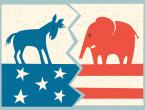Multi-agency analysis: non-agricultural upset again in September, the Fed’s November reduction is hopeless
Data released by the US Bureau of Labor Statistics on Friday (October 8) showed that the non-agricultural employment population in the United States increased by 194,000 after seasonal adjustments in September, and is expected to increase by 500,000. The previous value increased by 235,000. The unemployment rate in September fell to 4.8%. , Continuing to hit a new low since March 2020, expected 5.1%, the previous value was 5.2%, the average hourly wage rate in September was 4.6%, the expected 4.6%, and the previous value was 4.3%.
The US Bureau of Labor Statistics said that the number of new non-agricultural jobs in August was revised up from 235,000 to 366,000; the number of new non-agricultural jobs in July was revised up from 1.053 million to 1.091 million. The number of people employed in public education has declined this month. The number of non-agricultural employment increased by 194,000 in September, and the unemployment rate fell by 0.4 percentage points to 4.8%. There has been a significant increase in jobs in the leisure and hospitality industry, professional and business service industries. After the amendment, the total number of new jobs in August and September was 169,000 higher than previously reported.
According to the quick review, the non-agricultural upset in September increased by 194,000 people, which was much lower than expected, and the Fed may find it difficult to shrink in November. The September non-agricultural employment report showed that the number of employees increased by 194,000, which was a sharply lower than expected increase of 500,000. The September non-agricultural employment data was the only employment report available before the Fed’s policy meeting on November 2-3. .
Previously, the market generally expected that the Fed would begin to reduce the scale of monthly bond purchases in November. Fed Chairman Powell told reporters that “employment reports need to be reasonably strong” to reach the threshold for the Fed to cut its large-scale bond purchase program; September non-agricultural data will make investors question the health of the economy and make U.S. Treasury yields lower in the near future. This will also cause the market to raise bets on the Fed to postpone or slow down the pace of the reduction.
The non-agricultural employment population in the United States increased by only 194,000 in September, which is even worse than in August. It is far less than the market’s previous expectations of an increase of 500,000. At the same time, the unemployment rate has hit a new low since the outbreak. 4.8%. The data shows that the lack of employment willingness of the American people has led to sluggish employment growth that has not been reversed, although most federal unemployment subsidies have ended that month. Therefore, on the one hand, employment growth has been slow, and on the other hand, labor shortages have further increased the level of wage inflation. This situation is also bound to put the Fed's subsequent policy orientation into a more dilemma.
Financial website Forexlive commented on non-agricultural companies in September, saying that the increase in employment in September has brought the overall employment level back to the level of February 2020 (before the epidemic). However, the employment rate (that is, the employment ratio of people aged 15 and over) in September was 60.9%, 0.9 percentage points lower than in February 2020, because the population has grown by 1.4% in the past 19 months.
Bloomberg analyst commented on September non-agricultural Matthew Boesler said that according to revised data, the leisure and hospitality industry actually added 38,000 jobs in August, rather than the zero net growth first reported last month. Another 74,000 people were added in September. This is still far below the operating speed of the previous few months, but it may not be as bad as previously feared.
The growth rate of non-agricultural employment in the United States further slowed down in September and the unemployment rate continued to fall. The reason is that the employment participation rate of the whole society has further declined. Many low-paid, difficult jobs that require outdoor field work or close contact with customers are still difficult It's hard to fill.
(TD Securities) head of global interest rate strategy assessment in September non-farm TD Securities, said although the data upset, but the Fed continue to reduce the scale of debt purchased threshold of "very low", as long as the data is above zero, the Fed will purchase debt reduced scale. The market has digested expectations of reducing the scale of bond purchases. The most important thing now is when they start to raise interest rates.
Fxstreet analyst Joseph commented on September non-agricultural use that the US economy seems to be booming in other areas, but the second bad employment report will not prevent the Fed (at least not yet) from starting to reduce the scale of debt purchases. In fact, the Federal Open Market Committee can reduce bond purchases and wait for developments.
Bloomberg analyst Olivia Rockman commented on Non-Farmers in September that the sluggish employment growth for several months shows that a tug-of-war is being staged between employers and job seekers-employers urgently need employees to meet demand. But job seekers have been reluctant to return to the workplace. Nevertheless, as companies raise wages, the reopening of schools and the end of federal unemployment benefits should lead to an increase in hiring in the coming months.











